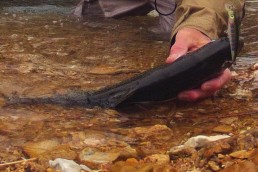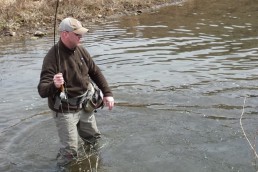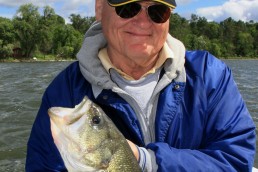A Trio of Trout-fishing Factors for the Meramec
SHARE THIS POST
The Meramec River flows practically out my back door, as I can be there in a matter of minutes. Coupled with the fabulous weather lately and the fact that the Missouri Department of Conservation has been making monthly stockings of brown trout, my close proximity to this river has prompted frequent fishing trips.
A cloudy, blustery, misty day may not be the ticket for fair-weather fishermen, but trout anglers recognize such days as perfect for pursuing this species.
First described in the 1758 edition of Systema Naturae by Swedish zoologist Carl Linnaues, brown trout have been introduced to many regions of the world and were first introduced into the U.S. in 1883 when Fred Mather, a New York pisciculturist and angler, acquired brown trout eggs from Baron Lucius von Behr, the president of the German Fishing Society. Subsequent introductions came from Scotland and England too, and specimens from all three locations were intermingled to create the American brown trout and a single species of the North European brown trout.
History lessons aside, my intent for my most recent trout excursion included getting to the river for a day to avoid the telephone, and my computer. And my choice of days paid off handsomely. I arrived at Maramec Spring Park around 10 a.m. Perhaps I would enjoy the river alone on this cloudy, dreary day. I scurried down the Marmaec Spring branch toward the Meramec River. I made quick time with my waders and wading shoes bundled up.
Fifteen minutes later, I slipped on my waders after putting several hundred yards between the park boundary and myself. I tied a 4 1/2-inch trout-colored stickbait onto my line. Brown trout are voracious meat-eaters and feed heavily under dark conditions.
I felt I had picked the perfect day.
And my speculations proved dead on. On my second cast into a deep swift pool, my spinning rod thumped in my hand. I set the hook and the first battle of the day with a brown trout ensued. The combined power of the current and strength of the lunging fish made it feel much larger than it was. Regardless, a pleasurable smile covered my face as I brought the wriggling fish to hand.
Minutes later, a surprising revelation came my way—I had hooked a brown in less than 18 inches of water. I had discovered, by accident, that fish were actively feeding in shallow riffles due to the dim light. I knew immediately that I was in for special day.
I began scanning the shallow riffles below deeper pools and soon began picking out the dark shapes of feeding brown trout. Stealth became the order of the day as I quietly and slowly approached the active fish. As soon as the fishing slowed in one riffle, I moved on to the next and repeated the process. And it worked like a charm. I felt a bit smug for having picked the right day to catch fish and avoid people.
I continued to catch brown after brown until the temptation to cast into a deep swift pool, which was choked with logs, overtook me. I snagged my prized stickbait, and I yanked and pulled, thrashing the water with my line. As my lure broke free, the water erupted. A big rainbow trout of 3 pounds crashed my lure. It tail-walked across the surface and gained its freedom.
Are you enjoying this post?
You can be among the first to get the latest info on where to go, what to use and how to use it!
I stood spellbound at what had just happened. Such moments engrain themselves into the minds of fishermen. Then, heavy wing beats behind me caught my attention. A dozen or so wild turkeys soared across the river, creating another magical moment.
Another logjam with swift water appeared up ahead. Perhaps, I could hook another big fish? Wrong—my first cast into the fray cost me my highly successful rainbow-colored stickbait.
Disheartened with the lure’s loss, I figured my good fishing for the day had ended. Then, 10 feet downstream, I found a 3-inch gold and black-colored Rapala partially buried in the sand. I’ve caught many trout on them over the years. I tied the Rapala to my line, and a dozen casts later, had my first Rapala brown of the day.
I continued downstream, having traveled much farther than intended. But the fishing proved phenomenal, and I wasn’t about to quit.
I then found another long riffle. To my surprise, it held both browns and rainbows. Two or three fish chased my Rapala with each cast. Fifteen minutes later, the action slowed. I had caught half a dozen fish. I then moved downstream. Ahead, a long pool dropped into a shallow run. Just for a change, I tied on a rainbow-colored Rooster Tail and caught a rainbow trout on my first cast. Several more bows fell to the flashy Rooster Tail.
Weary but happy, I began the three-mile hike back to the truck. I revisited several spots on the way back and picked up more brown trout.
I encountered two older gentlemen near the park boundary and we exchanged greetings.
I nodded and said, “Okay,” when they asked how I did.
If they had only known about the powerful combination of living close to the river, fishing on a gloomy day and knowing that lots of browns finned the shallows far downstream, they would’ve been okay too.
MWO
SHARE THIS POST
Did you enjoy this post?
You can be among the first to get the latest info on where to go, what to use and how to use it!
Bill Cooper
An inductee to the National Fresh Water Fishing Hall of Fame, Bill Cooper, from the Missouri Ozarks, has written over 4,000 articles on outdoor subjects. You can hear him on Wild at Heart Outdoor radio at espn1073.com.



